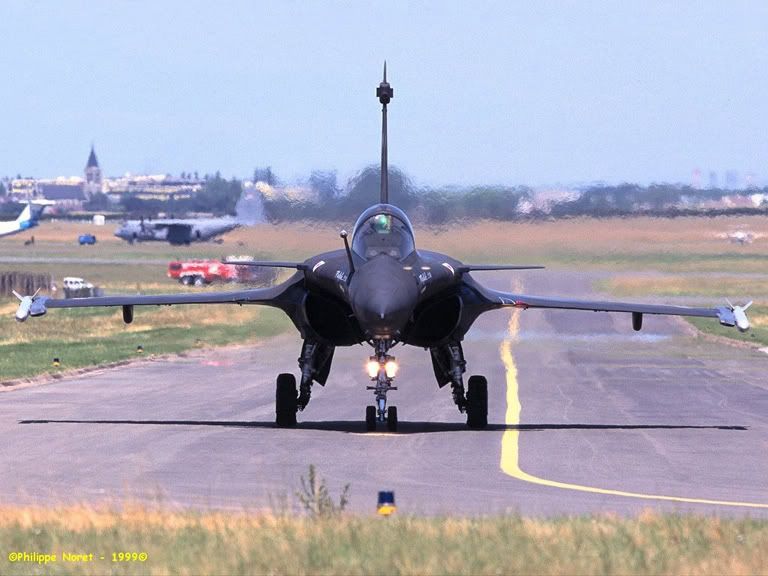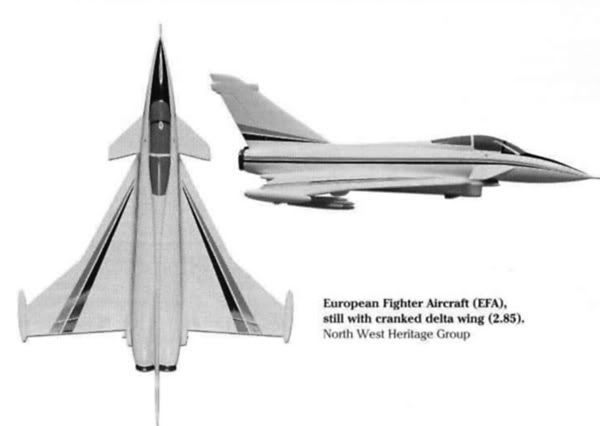PRick escreveu:[ quote="Penguin"]
PRick escreveu:
Se você voltar as antepassados, verá que os Alemães foram os responsáveis pelo desenho básico do Typhoon, não só os desenvolvimentos da DASA, fruto da parceria com os EUA, eles modificaram um F-104 para fazer testes de FBW, CCV em caças. Porém, existe uma diferença fundamental entre o protótipo da DASA e o Typhoon. A altura onde o canard está colocado.
A crítica da Dassault é que a configuração escolhida teria problemas. Uma das causas da Dassault ter saido do projeto, porque tinha grande experiência em caças canard´s delta, sobretudo do M-4000. Em resumo, os canhard´s não devem ser colocados no mesmo nível da asa delta. Apesar de melhorar a capacidade de manobra, torna aerodinâmica e a configuração muito instável, o resultado geral é que no papel o Typhoon deveria até ser mais manobrável que o Rafale, porém, devido aos perigos da configuração, o FBW/CCV teve que ser colocado de modo mais conservador que o Rafale, não havendo como "desligar" ele, diferentemente, do que ocorre com o Rafale.
Uma análise mais detida, veremos que o J-37, Gripen, M-2000, M-4000 e Rafale usam os canard´s em nível diferente da asa delta, não causando turbulência na mesma, quando acionados em altos ângulos. Não é preciso dizer que isso ocasiona perda de eficiência da asa delta.
[]´s
Prick,
A Dassault saiu do EFA por que ela queria deter 50% da carga de trabalho de desenvolvimento no novo caça. Coisa que os parceiros não aceitaram. Além disso,a França queria priorizar naqueles tempos um caça leve e que pudesse operar em porta aviões. Quanto a um caça leve isso acabou não se concretizando. A Europa perdeu uma chance de ouro de ter apenas um único caça e com grande escala de produção. Provavelmente não haveria espaço para o F-35 no continente Europa.
Vc quer dizer que o FBW e FCS do Typhoon o torna menos manobrável do que o Rafale? Mal te pergunte, onde vc leu tal coisa? Qual a explicação para o que vc escreveu (em azul)?
Os caças de 4a geração costumam ter "estabilidade relaxada". Sem FBW e FCS são virtualmente impossíveis de controlar. Como isso seria possível no Rafale?
[]s
Santiago,
Eu diria que aqui é tudo a mesma coisa, a Dassault queria o controle para definir a configuração final, menor e mais flexível que a configuração proposta. Como vc mesmo observou o Rafale apesar de mais leve que o Typhoon, não é de modo nenhum uma aeronave leve.
Algumas de suas perguntas já foram muito respondidas aqui no fórum, o Rafale, como o M-2000 tem um sistema no manche, que quando o piloto força o batente são desarmados as limitações do CCV, ou FCS em inglês. Algo que não existe no Typhoon, F-16, Gripen por exemplo. Existem fotos desse sistema em funcionamento aqui, quando o Rafale chega a 11 g´s, ele faz isso e alerta o piloto que ele está excedendo o limite do FCS. O piloto é quem decide quando deve arriscar. Todos os caças de 4 geração tem estabilidade relaxada, porém, isso é feito em graus, alguns são mais instáveis naturalmente que outros. Infelizmente não tenho a fonte desse texto aqui, apenas que era uma Revista Francesa.
Like many other aircraft makers, Dassault has selected a delta-canard configuration for its latest design. “As we were working with the other Europeans, we started to diverge significantly on the design” explains Bruno Revellin-Falcoz [Director of Dassault’s Technical Department]. “Ultimately, we made some radically different choices. They wanted fuselage-mounted canards while we preferred to locate the canards almost above the wing-root. The key advantage of this configuration was that it would channel the air flow over the wing apex, which is where lift-generating vortices are formed. The Eurofighter Typhoon uses its canards as simple control surfaces. Although this creates a significant lever effect, it loses the positive impact on lift and therefore aerodynamic efficiency. That’s why we are certain that the Rafale can handle much better than the Typhoon at high angles of attack, such as during the crucial phases of dogfighting and low-speed flight. While they were groping around in the dark, we benefited from the know-how accumulated through the Mirage III Milan, Mirage III NG and Mirage 4000 programmes.
Disadvantages of a closed coupled Canard is
• Possibility for adverse flow disturbances over the wing from the canard.
• High canard CLmax leads to low efficiency e, and high e leads to low CLmax.
• Generally have a small moment arm to VT, close coupled canard requiring a larger area as a long coupled canard.
The 'bravest' way to use canards is the the Typhoon way. Much mounted well forward of the wing which greatly increases the moment arm and minimises the effects of downwash on the inner main wing. The Typhoon is the only fighter to use this form as the Rafale, Flanker, J-10, Gripen et al use the safer, less destabilising 'close coupled' arrangement. Computer testing is said to demonstrate that adding TVC to the Typhoon would not enhance agility, despite test engines have been bench run already.


Vejam a comparação com a localização dos canard´s do Rafale.

O mais interessante é que os primeiros desenhos e esboços do Typhoon eram assim.

Pelo que as pessoas falam, a configuração do Typhoon teria que ser completada com TVC para que as características ruins do posicionamento do Canard fossem compensadas, daí isso é citado para a possível versão naval.
O resultado geral é que até 1.6 Mach o Rafale tem melhor performance que o Typhoon, a velocidade mínima em voo controlado é 70 nós contra 100 nós por exemplo.
Disso decorre em dizer que o Typhoon tem melhor capacidade de Superioridade Aérea, dado que em velocidades acima de 1,6 Mach sua configuração apresenta vantagens segundo dizem[High Alpha Velocity Vector Roll (HAVVR)], mas fico pensando, algum caça manobra a essa velocidade ou apenas voa quase em linha reta? Creio que aqui a vantagem do Typhoon seja a relação empuxo x peso um pouco superior ao Rafale. Além de poder levar mais mísseis BVR de longo alcance em sua configuração normal de combate ar-ar.
[]´s[/quote]
--------------------------------------------------------------------------------------------------------
O que vc descreve acima (em vermelho) parece estar equivocado.
Segundo relato postado neste Forum, recentemente o Gripen da Africa do Sul lançou um A-Darter em uma manobra a 12G durante ensaios deste míssil.
O site oficial do Typhoon diz que seu FCS permite que os limites pre-estabelecidos sejam ultrapassados em caso de necessidade/emergência (o F-18A/C/E também possui sistema similar. O F-16 não sei. O Gripen parece possuir sistema similar):
Flight Control Systems
The FCS is a full-authority, quadruplex digital
Fly-By-Wire system providing:
- Stability and control augmentation
- High agility
- Full carefree handling and manoeuvring
It is designed to enable the pilot to concentrate on the tactical tasks and to fly the aircraft 'head-up' in combination with the HOTAS (Hand-on-Throttle-and-Stick) concept applied to cockpit design. Emergency features have also been embodied in the system design to ensure maximum safety of operation.
These include:
- Low speed auto recovery
-
Emergency 'g' override
- 'g' onset limitation
- Dis-Orientation Recovery Capability (DORC)
- Automatic reversion
The system is designed to provide the necessary measurement (Air Data System) computation and surface actuation needed to perform all required manoeuvres ensuring carefree handling and manoeuvring capabilities.
The system is also designed to provide higher mode functionalities including:
- Autopilot
- Auto-throttle
- Flight Director Modes
The system is controlled by four Flight Control Computers and features primary and secondary actuation to ensure control along all axis (pitch, roll and yaw). The aerodynamic configuration is automatically trimmed to achieve an optimum compromise between performance and manoeuvrability.
Pitch control is provided by symmetric operation of foreplanes and wing flaperons, while roll control is primarily achieved through differential operation of wing flaperons. Yaw control is primarily provided by the fin mounted rudder. Cross feeds among the various actuation systems are also implemented to optimise aircraft performance and handling qualities. The slats and flaperons automatically optimise the wing camber at all Angles of Attack (AOA).
The FCS also features automatic reversion through various back-up modes. It is integrated with other systems through the avionics (STANAG 3910) and utility control (STANAG 3838) data buses.
http://www.eurofighter.com/capabilities ... ystem.html
Aerodynamic Characteristics
Perfection in airframe performance can give the pilot battle-winning edge, providing that airframe is part of the Eurofighter Typhoon Weapon System.
Eurofighter Typhoon has a foreplane/delta configuration which is, by nature, aerodynamically unstable.
The instability of the aircraft is derived from the position of a theoretical “pressure point” on the longitudinal axis of the aircraft. This is calculated from the contribution to lift from each of the aircraft components (the wings, the canards, fuselage etc). If the pressure point is in front of the centre of gravity on the longitudinal axis, the aircraft is aerodynamically unstable and it is impossible for a human to control it.
With the Eurofighter Typhoon, in subsonic flight the pressure point lies in front of the centre of gravity, therefore making the aircraft aerodynamically unstable, and is why Eurofighter Typhoon has such a complex Flight Control System – computers react quicker than a pilot.
When Eurofighter Typhoon crosses into supersonic flight, the pressure point moves behind the centre of gravity, giving a stable aircraft.
The advantages of an intentionally unstable design over that of a stable arrangement include greater agility – particularly at subsonic speeds - reduced drag, and an overall increase in lift (also enhancing STOL performance).
http://www.eurofighter.com/capabilities ... stics.html
Com relação ao porque da posição do canard do Typhoon...
(...)
Unusually the canards are mounted much nearer the nose than is typically found in similar aircraft. This increases the maximum achievable Angle of Attack (AoA). The drawback to this is a decreased view to the left and right of the pilot. Automatic slats are present on the main wing leading edges which ensure the correct wing camber is maintained across the flight envelope. A hydraulically operated air-brake is integrated behind the cockpit, moving into a near-vertical position to maximise drag when required.(...)
http://typhoon.starstreak.net/Eurofight ... cture.html
Adicionalmente há dois pequenos strakes (superficies) acima e atrás no canard:

 There are small strakes on the fuselage below the cockpit and above and behind the canard fins to make sure that airflow over the wing remains effective at high angles of attack.
There are small strakes on the fuselage below the cockpit and above and behind the canard fins to make sure that airflow over the wing remains effective at high angles of attack.
[]s













